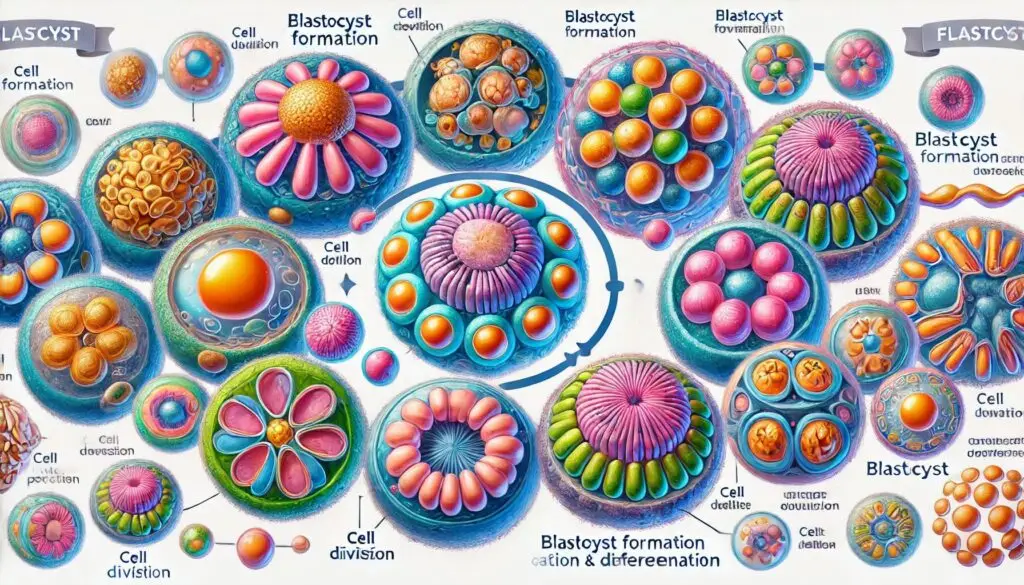Prenatal Growth in Animals

Introduction to Prenatal Growth
Prenatal growth refers to the development of an embryo and fetus during gestation. This process is vital for ensuring that offspring are born healthy and capable of thriving. The prenatal period is marked by rapid changes and adaptations that set the stage for postnatal life.
Stages of Prenatal Development
Prenatal development can be categorized into two main stages: embryonic development and fetal development.
Embryonic Development
Embryonic development begins at fertilization and continues until around the 10th week of gestation. During this period, critical structures form, including:
- Blastocyst Formation: The zygote divides multiple times to create a blastocyst, which implants into the uterine wall.
- Organogenesis: Major organs begin to develop during this stage. This process is crucial as it lays the foundation for all bodily systems.
For a more detailed exploration of embryonic stages, you can check out Wikipedia on Prenatal Development.
Fetal Development
Fetal development starts around the 10th week of gestation and continues until birth. This stage involves significant growth and maturation of organs. Key aspects include:
- Growth Rates: The fetus experiences linear growth until about 37 weeks of gestation.
- Organ Maturation: By this time, all major structures are formed but continue to develop functionally.
The importance of this stage cannot be overstated; it is during this time that many health issues can arise if proper conditions are not maintained.
Factors Influencing Prenatal Growth
Several factors impact prenatal growth, including genetic makeup, maternal nutrition, environmental conditions, and hormonal influences.
Genetic Factors
Genetics play a crucial role in determining an animal’s potential size and health. Different breeds may exhibit variations in growth rates due to inherited traits. Understanding these genetic influences helps in breeding programs aimed at improving livestock productivity.
Maternal Nutrition
Maternal nutrition is perhaps the most significant external factor affecting fetal growth. Adequate nutrition ensures that the developing fetus receives essential nutrients. Studies have shown that malnutrition can lead to:
- Intrauterine Growth Retardation (IUGR): This condition results from inadequate nutrient supply and can have lasting effects on postnatal health.
- Long-term Health Issues: Poor prenatal nutrition can lead to chronic health problems later in life.
For further insights into how prenatal nutrition impacts animal production, refer to Impacts of Prenatal Nutrition on Animal Production.
Environmental Conditions
Environmental factors such as temperature and altitude can also affect fetal development. Adverse conditions may impair placental function and nutrient transfer. Ensuring a stable environment is essential for optimal fetal growth.
Hormonal Influences
Hormones regulate many aspects of fetal growth. Maternal hormonal levels can influence nutrient transfer from mother to fetus. Disruptions in hormonal balance may lead to complications during pregnancy.
Consequences of Impaired Prenatal Growth
Impaired prenatal growth can lead to various negative outcomes for both the offspring and the mother.
Reduced Neonatal Survival
Animals born with IUGR often experience lower survival rates due to underdeveloped organs or compromised physiological functions. This highlights the importance of monitoring maternal health throughout pregnancy.
Stunted Growth
Offspring born small for gestational age frequently exhibit reduced growth potential throughout their lives. This stunting affects weight gain and overall health.
Long-term Health Issues
Research indicates that impaired prenatal growth can lead to chronic health issues later in life. These include metabolic disorders and reduced reproductive performance.
For a comprehensive review on intrauterine growth retardation, see Intrauterine Growth Retardation: Implications for Animal Sciences.
Understanding Fetal Programming
Fetal programming refers to how prenatal conditions affect future health outcomes. The concept emphasizes that early life experiences shape physiological responses later in life.
The Role of Nutrition in Fetal Programming
Nutrition during pregnancy impacts fetal programming significantly. Adequate maternal nutrition supports healthy fetal development while malnutrition can lead to adverse outcomes:
- Muscle Development: In ruminants like sheep, muscle fiber formation occurs during early gestation. Undernutrition during this period reduces muscle fiber numbers.
- Fat Development: Adipose tissue formation primarily occurs late in gestation. Nutritional status during this time influences fat deposition patterns in offspring.
For more information on how fetal programming affects skeletal muscle development in ruminants, refer to Fetal Programming in Ruminant Animals.
Environmental Influences on Fetal Programming
Environmental factors also play a role in fetal programming:
- Stressors: Exposure to stressors such as extreme temperatures or toxins can alter developmental pathways.
- Maternal Health: The overall health of the mother directly affects fetal outcomes. Chronic diseases or infections can compromise fetal development.
Strategies for Optimizing Prenatal Growth
To enhance prenatal growth outcomes, several strategies can be implemented:
Nutritional Interventions
Ensuring that pregnant animals receive balanced diets rich in essential nutrients is crucial. Nutritional interventions may include:
- Supplementation: Providing vitamins and minerals that support fetal development.
- Dietary Adjustments: Modifying feed based on specific needs during different gestational stages.
Monitoring Maternal Health
Regular veterinary check-ups can help monitor maternal health throughout pregnancy. Early detection of potential issues allows for timely interventions.
Environmental Management
Creating a stable environment free from stressors promotes healthy fetal development. This includes managing temperature, humidity, and housing conditions effectively.
Conclusion
Understanding prenatal growth in animals is essential for improving animal welfare and productivity. By focusing on key factors such as maternal nutrition and environmental conditions, we can enhance outcomes for both mothers and their offspring. Continued research into these areas will further our knowledge and improve practices within animal husbandry.
For further reading on prenatal development topics, you might find these resources helpful:
More from Veterinary Physiology:
https://wiseias.com/abo-blood-group-system-animals/
https://wiseias.com/anticoagulation-in-animals/
https://wiseias.com/hemorrhagic-disorders-in-animals/






Responses